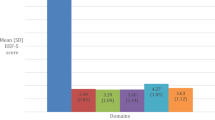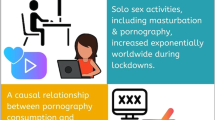Abstract
This cross-sectional study aimed to investigate the effect of the frequency of using pornography on psychogenic erectile dysfunction severity after controlling for other psychological factors. It then evaluated the mediating role of dyadic adjustment regarding this. This study included 66 young married heterosexual male patients who were diagnosed with psychogenic erectile dysfunction after organic causes were excluded. The patients filled out the form about demographics, the age of onset of pornography use, and the frequency of pornography use. All participants were evaluated using a comprehensive data form, the International Index of Erectile Function, the Dyadic Adjustment Scale, the Patient Health Questionnaire-Somatic, Anxiety, and Depressive Symptoms, the Perceived Stress Scale, and the Rosenberg Self-Esteem Scale. A significant strong negative correlation was determined between the International Index of Erectile Function scores and pornography use frequency (r = –0.535 and p < 0.001). Pornography use frequency and Dyadic Adjustment Scale scores were found to have a significant predictive effect on erectile dysfunction scores in hierarchical regression analysis after controlling for somatization, depression, and perceived stress, which are typically correlated with erectile dysfunction scores (Beta = −0.28, and 0.34 respectively, p = 0.02, and 0.01 respectively). The Sobel test conducted to evaluate the mediating effect of dyadic adjustment revealed that dyadic adjustment played a mediating role in the correlation between pornography use frequency and erectile dysfunction scores (z = –1.988 and p = 0.047, respectively). The most significant observation of this study was the specific causative effect of pornography use frequency on erectile dysfunction severity through dyadic adjustment, especially considering that the frequency of using pornography is a modifiable factor.
This is a preview of subscription content, access via your institution
Access options
Subscribe to this journal
Receive 8 print issues and online access
$259.00 per year
only $32.38 per issue
Buy this article
- Purchase on Springer Link
- Instant access to full article PDF
Prices may be subject to local taxes which are calculated during checkout
Similar content being viewed by others
Data availability
The data associated with the study is available and can be shared on reasonable request.
References
Nicolosi A, Laumann EO, Glasser DB, Moreira ED Jr, Paik A, Gingell C. Sexual behavior and sexual dysfunctions after age 40: the global study of sexual attitudes and behaviors. Urology. 2004;64:991–7.
Landripet I, Štulhofer A. Is pornography use associated with sexual difficulties and dysfunctions among younger heterosexual men? J Sex Med. 2015;12:1136–9.
Braun M, Wassmer G, Klotz T, Reifenrath B, Mathers M, Engelmann U. Epidemiology of erectile dysfunction: results of the ‘Cologne Male Survey. Int J Impot Res. 2000;12:305–11. https://www.nature.com/articles/3900622.
Martins FG, Abdo CHN. Erectile dysfunction and correlated factors in Brazilian men aged 18–40 years. J Sex Med. 2010;7:2166–73.
Salonia A, Castagna G, Saccà A, Ferrari M, Capitanio U, Castiglione F, et al. Is erectile dysfunction a reliable proxy of general male health status? The case for the international index of erectile function—erectile function domain. J Sex Med. 2012;9:2708–15. https://linkinghub.elsevier.com/retrieve/pii/S1743609515337632.
Papagiannopoulos D, Khare N, Nehra A. Evaluation of young men with organic erectile dysfunction. Asian J Androl. 2015;17:11.
Seftel AD, Sun P, Swindle R. The prevalence of hypertension, hyperlipidemia, diabetes mellitus and depression in men with erectile dysfunction. J Urol. 2004;171:2341–5.
Hedon F. Anxiety and erectile dysfunction: a global approach to ED enhances results and quality of life. Int J Impot Res. 2003;15:S16.
Shamloul R, Ghanem H. Erectile dysfunction. Lancet. 2013;381:153–65.
Park BY, Wilson G, Berger J, Christman M, Reina B, Bishop F, et al. Is Internet pornography causing sexual dysfunctions? A review with clinical reports. Behav Sci. 2016;6:17.
Wylie K, Pacey AA. Using erotica in government‐funded health service clinics. J Sex Med. 2011;8:1261–5.
Janssen E, Bancroft J. The dual-control model: the role of sexual inhibition and excitation in sexual arousal and behavior. Psychophysiol Sex. 2007;15:197–222.
Klein V, Jurin T, Briken P, Štulhofer A. Erectile dysfunction, boredom, and hypersexuality among coupled men from two European Countries. J Sex Med. 2015;12:2160–7.
Ponholzer A, Temml C, Mock K, Marszalek M, Obermayr R, Madersbacher S. Prevalence and risk factors for erectile dysfunction in 2869 men using a validated questionnaire. Eur Urol. 2005;47:80–6. https://linkinghub.elsevier.com/retrieve/pii/S0302283804004178.
Doornwaard SM, Bickham DS, Rich M, Vanwesenbeeck I, van den Eijnden RJJM, Ter Bogt TFM. Sex-related online behaviors and adolescents’ body and sexual self-perceptions. Pediatrics. 2014;134:1103–10.
Wright PJ, Steffen NJ, Sun C. Is the relationship between pornography consumption frequency and lower sexual satisfaction curvilinear? Results from England and Germany. J Sex Res. 2019;56:9–15.
Rosen RC, Riley A, Wagner G, Osterloh IH, Kirkpatrick J, Mishra A. The international index of erectile function (IIEF): a multidimensional scale for assessment of erectile dysfunction. Urology. 1997;49:822–30.
Akkus E, Kadioglu A, Esen A, Doran S, Ergen A, Anafarta K, et al. Prevalence and correlates of erectile dysfunction in Turkey: a population-based study. Eur Urol. 2002;41:298–304. https://linkinghub.elsevier.com/retrieve/pii/S0302283802000271.
Tokatli Z, Akand M, Yaman O, Gulpinar O, Anafarta K. Comparison of international index of erectile function with nocturnal penile tumescence and rigidity testing in evaluation of erectile dysfunction. Int J Impot Res. 2006;18:186–9. https://www.nature.com/articles/3901390.
Eddy JM, Heyman RE, Weiss RL. An empirical evaluation of the Dyadic Adjustment Scale: exploring the differences between marital” satisfaction” and” adjustment.”. Behav Assess. 1991;13:199–220.
Fişiloğlu H, Demir A. Applicability of the Dyadic Adjustment Scale for measurement of marital quality with Turkish couples. Eur J Psychological Assess. 2000;16:214.
Kroenke K, Spitzer RL, Williams JBW. The PHQ‐9: validity of a brief depression severity measure. J Gen Intern Med. 2001;16:606–13.
Yazici Güleç M, Güleç H, Şimşek G, Turhan M, Aydin Sünbül E. Psychometric properties of the Turkish version of the Patient Health Questionnaire-Somatic, Anxiety, and Depressive Symptoms. Compr Psychiatry. 2012;53:623–9.
Cohen S, Kamarck T, Mermelstein R. A global measure of perceived stress. J Health Soc Behav. 1983;24:385–96.
Eskin M, Harlak H, Demirkıran F, Dereboy Ç. Algılanan stres ölçeğinin Türkçeye uyarlanması: güvenirlik ve geçerlik analizi. New/Yeni Symp J. 2013;132–40.
Rosenberg M. Rosenberg self-esteem scale (RSE). Acceptance and commitment therapy Measures package. 1965;61:52.
Çuhadaroğlu F. Adolesanlarda benlik saygısı (Uzmanlık tezi). Hacettepe Üniversitesi Tıp Fakültesi Psikiyatri Anabilim Dalı, Ankara. 1986.
Moore TM, Strauss JL, Herman S, Donatucci CF. Erectile dysfunction in early, middle, and late adulthood: symptom patterns and psychosocial correlates. J Sex Marital Ther. 2003;29:381–99.
Rosen RC. Psychogenic erectile dysfunction: classification and management. Urol Clin North Am. 2001;28:269–78.
Smith JF, Breyer BN, Eisenberg ML, Sharlip ID, Shindel AW. Sexual function and depressive symptoms among male North American medical students. J Sex Med. 2010;7:3909–17. https://linkinghub.elsevier.com/retrieve/pii/S1743609515327910.
Jern P, Gunst A, Sandnabba K, Santtila P. Are early and current erectile problems associated with anxiety and depression in young men? A retrospective self-report study. J Sex Marital Ther. 2012;38:349–64. http://www.tandfonline.com/doi/abs/10.1080/0092623X.2012.665818.
Fanni E, Castellini G, Corona G, Boddi V, Ricca V, Rastrelli G, et al. The role of somatic symptoms in sexual medicine: somatization as important contextual factor in male sexual dysfunction. J Sex Med. 2016;13:1395–407.
Aghighi A, Grigoryan VH, Delavar A. Psychological determinants of erectile dysfunction among middle-aged men. Int J Impot Res. 2015;27:63–8.
Grubbs JB, Gola M. Is pornography use related to erectile functioning? Results from cross-sectional and latent growth curve analyses. J Sex Med. 2019;16:111–25.
Wéry A, Billieux J. Online sexual activities: an exploratory study of problematic and non-problematic usage patterns in a sample of men. Comput Hum Behav. 2016;56:257–66.
Pizzol D, Bertoldo A, Foresta C. Adolescents and web porn: a new era of sexuality. Int J Adolesc Med Health. 2016;28:169–73.
Voon V, Mole TB, Banca P, Porter L, Morris L, Mitchell S, et al. Neural correlates of sexual cue reactivity in individuals with and without compulsive sexual behaviours. PLoS One. 2014;9:e102419.
Riley A. The role of the partner in erectile dysfunction and its treatment. Int J Impot Res. 2002;14:S105–9.
Poulsen FO, Busby DM, Galovan AM. Pornography use: who uses it and how it is associated with couple outcomes. J Sex Res. 2013;50:72–83.
Hare K, Gahagan J, Jackson L, Steenbeek A. Perspectives on “Pornography”: exploring sexually explicit Internet movies’ influences on Canadian young adults’ holistic sexual health. Can J Hum Sex. 2014;23:148–58.
Perry SL. Does viewing pornography reduce marital quality over time? Evidence from longitudinal data. Arch Sex Behav. 2017;46:549–59.
Zillmann D. Influence of unrestrained access to erotica on adolescents’ and young adults’ dispositions toward sexuality. J Adolesc Health. 2000;27:41–4.
Author information
Authors and Affiliations
Contributions
All authors have provided substantial contributions to the research design, or have helped with the acquisition, analysis or interpretation of the data, or drafted the paper, or revised it critically. All authors approved the submitted and final versions. Project administration: OKK, OK, OE, BE, AY, Material preparation: OKK, OK, OE, Data collection: OKK, OK, OE, Writing-Original draft: OKK, OK, Writing - Review & Editing: OE, BE, AY, Supervision: BE, AY.
Corresponding author
Ethics declarations
Competing interests
The authors declare no competing interests.
Additional information
Publisher’s note Springer Nature remains neutral with regard to jurisdictional claims in published maps and institutional affiliations.
Supplementary information
Rights and permissions
Springer Nature or its licensor (e.g. a society or other partner) holds exclusive rights to this article under a publishing agreement with the author(s) or other rightsholder(s); author self-archiving of the accepted manuscript version of this article is solely governed by the terms of such publishing agreement and applicable law.
About this article
Cite this article
Kazan Kizilkurt, O., Kazan, O., Efiloglu, O. et al. Effect of internet pornography use frequency on psychogenic erectile dysfunction severity in young Turkish men: the mediating role of dyadic adjustment. Int J Impot Res (2023). https://doi.org/10.1038/s41443-023-00804-3
Received:
Revised:
Accepted:
Published:
DOI: https://doi.org/10.1038/s41443-023-00804-3



